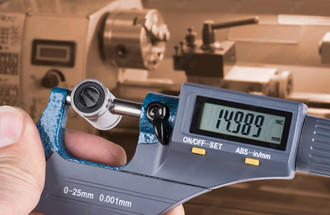Posted by Penn Tool Co., Inc on 6th Jul 2023
How Do You Use a Micrometer?
Precision is vital in any woodworking or metalworking business. Accurate measurements ensure the quality and compatibility of every component.
That's why micrometers are such an essential tool in these industries. These tools provide precise measurements to a fraction of a millimeter.
In this article, the precision metrology experts at Penn Tool Co. discuss the best practices for using a micrometer to achieve accurate results and eliminate the guesswork from your measurements.
Micrometer Guide for Beginners: How to Read a Micrometer
- Prepare
- Grasp
- Grip
- Read
A micrometer is a hand-held tool that measures very small distances with high precision. But how do you use them effectively?
1. Prepare Your Micrometer
Before measurement, wipe the anvil and spindle clean to remove any debris or dust that could affect your readings. Make sure that your micrometer is properly calibrated; if you're using a new micrometer, consult the manufacturer's instructions to ensure proper calibration.
2. Grasp the Micrometer
To use your micrometer, grasp the frame with one hand and the thimble with the other. Hold the micrometer so that the spindle faces upward.
3. Grip Your Workpiece
Position the spindle on your workpiece and apply enough pressure to ensure that the spindle is firmly in place.
4. Read the Measurement
To take a measurement, turn the thimble until the spindle makes contact with the workpiece. Be sure to use a light touch, as too much force can compress the workpiece and lead to inaccurate readings.
How to Read a Micrometer
It's important to understand how to read a micrometer. They have two scales that work together to provide a precise measurement, the primary scale and the vernier scale.
The Primary Scale of the Micrometer
The primary scale is usually divided into 0.5mm or 0.1mm increments, depending on the micrometer.
Each full revolution of the thimble moves the spindle along the primary scale by one increment. The primary scale reading is the number of whole millimeters that the spindle has moved.
The Vernier Scale of the Micrometer
The vernier scale provides additional increments that enable more precise measurements. It's important to note that the smallest increment on the vernier scale is usually half that of the primary scale.
To read the vernier scale, locate the line on the vernier scale that aligns with a line on the primary scale. This gives you the number of additional tenths of a millimeter.
The final measurement is the sum of the primary scale reading and the vernier scale reading.
Find Precision Measuring Tools at Penn Tool Co.
In conclusion, micrometers are essential tools for achieving precise measurements in woodworking and metalworking operations. Understanding how to use a micrometer correctly is critical to achieving accurate results.
By following the steps outlined in this guide, you ensure that you're using your micrometer correctly and achieving the level of precision necessary for success. And if you need to invest in new measuring tools, Penn Tool Co. has everything you need to equip your workshop with the best equipment available.
At Penn Tool Co. our wide selection of micrometers and other measuring tools maximize precision in your shop. To find the best precision measurement tools for your operations, reach out to our team today.

